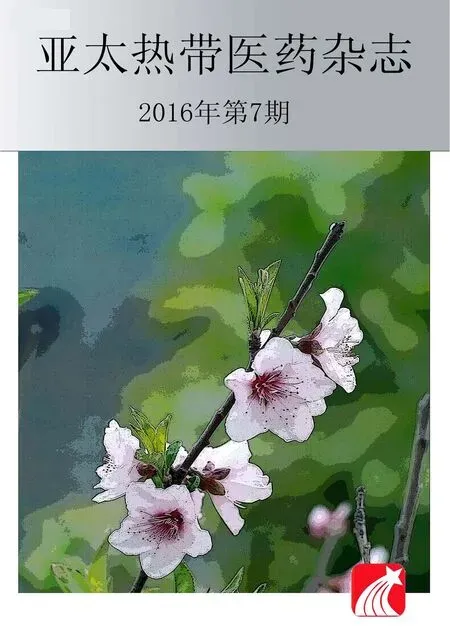Hum idity that is appropriate for Zika virus infection: A summary from Thai cases
2016-03-17BeuyJoobVirojiwanitkit
Beuy Joob, Viroj W iwanitkit
1Sanitation 1 Medical Academic Center, Bangkok, Thailand2Faculty of Medicine, University of Nis, Serbia3Hainan Medical University, Haikou, China4Joseph Ayobabalola University, Ikeji-Arakeji, Nigeria5Dr DY Patil Medical University, Pune, India
Hum idity that is appropriate for Zika virus infection: A summary from Thai cases
Beuy Joob1*, Viroj W iwanitkit2,3,4,5
1Sanitation 1 Medical Academic Center, Bangkok, Thailand
2Faculty of Medicine, University of Nis, Serbia
3Hainan Medical University, Haikou, China
4Joseph Ayobabalola University, Ikeji-Arakeji, Nigeria
5Dr DY Patil Medical University, Pune, India
AR T ICLE IN FO
Article history:
Received 15 April 2016
Received in revised form 16 May 2016 Accepted 15 June 2016
Available online 20 July 2016
Keywords:
Zika virus
Humidity
Infection
ABSTRACT In the present day, Zika virus infection is a big problem in medicine. As a mosquito borne infectious disease, the climate parameters including hum idity can affect the disease suitability. However, there is no previous data on the appropriate hum idity level that can promote Zika virus infection. Here, the authors analyze the data on hum idity where the Zika infections are detected in Thailand and found that the average humidity is equal to (66.14%±19.86%), which is the level that can be seen in several areas of the world including to non-tropical countries. This implies that there is a possible risk of Zika virus infection in the non-tropical country with appropriate hum idity level.
E-mail: beuyjoob@hotmail.com
Dear Editor,
Zika virus is a problematic arboviral infection at present. Its spreading and outbreaks in several areas of the world bring a big concern to the medical society. Dengue-like illness is the main clinical feature of Zika virus infection[1,2]. As a mosquito borne infection, climate parameter seems to be an important affecting disease suitability[3]. Temperature and hum idity are the common climate parameters that are usually mentioned for the effects on the mosquito borne infectious disease epidem iology[3-4]. The interrelationship between ‘climate and mosquito abundance’ is well defined[4]. It is well-known that the Zika virus infection is common in tropical zone with hot temperature. However, it lacks for the information on appropriate hum idity that promote emergence of disease. Here, the authors analyze the data on humidity at the sites where the Zika infections are detected in Thailand. The data on 7 cases in Thailand is appraised[5]. The data on humidity at each site is collected and used for further summative analysis. For analysis,average of hum idity level is calculated by descriptive statistical analysis. According to this study, the average hum idity is equal to (66.14%±19.86%) with m in=33 % and max=94 %. The estimated range of humidity is between 51.30% and 81.15%. This estimated range is w ider than that previously reported (80%±5%) in the publication by Diagne et al[6]. The determ ined humidity level is also concordant with the previous report by Chouin-Carneiro et al. that the condition ‘16 h: 8 h light: dark cycle and 80% hum idity’could promote suitability of disease transm ission in experimented mosquito vector[7]. Of interest, this range of humidity can be seen in several areas of the world including to non-tropical zones. Hence,the chance of worldw ide epidem ic of Zika virus infection can be expected.
Conflict of interest statement
We declare that we have no conflict of interest.
References
[1] Wiwanitkit S, Wiwanitkit V. Acute viral hemorrhage disease: A summary on new viruses. J Acute Dis 2015; 4(4): 277-279.
[2] Joob B, Wiwanitkit V. Zika virus infection and dengue: A new problem in diagnosis in a dengue-endem ic area. Ann Trop Med Public Health 2015; 8(4): 145-146.
[3] Shope R. Global climate change and infectious diseases. Environ Health Perspect 1991; 96: 171-174.
[4] Althouse BM, Hanley KA, Diallo M, Sall AA, Ba Y, Faye O, et al. Impact of climate and mosquito vector abundance on sylvatic arbovirus circulation dynam ics in Senegal. Am J Trop Med Hyg 2015; 92: 88-97.
[5] Buathong R, Hermann L, Thaisom boonsuk B, Rutvisuttinunt W,K lungthong C, Chinnawirotpisan P, et al. Detection of Zika virus infection in Thailand, 2012-2014. T Am J Trop Med Hyg 2015; 93(2): 380-383.
[6] Diagne CT, Diallo D, Faye O, Ba Y, Faye O, Gaye A, et al. Potential of selected Senegalese Aedes spp. mosquitoes (Diptera: Culicidae) to transmit Zika virus. BMC Infect Dis 2015; 15: 492.
[7] Chouin-Carneiro T, Vega-Rua A, Vazeille M, Yebakima A, Girod R, Goindin D, et al. Differential susceptibilities of Aedes aegypti and Aedes albopictus from the Americas to Zika Virus. PLoS Negl Trop Dis 2016; 10: e0004543.
doi:Document heading 10.1016/j.apjtm.2016.05.016
*Corresponding author:Beuy Joob, Sanitation 1 Medical Academic Center, Bangkok Thailand.
杂志排行
Asian Pacific Journal of Tropical Medicine的其它文章
- Predicted pattern of Zika virus infection distribution with reference to rainfall in Thailand
- Effect of partial splenic embolization on the immune function of cirrhosis patients with hypersplenism
- Perfusion of gastrodin in abdom inal aorta for alleviating spinal cord ischem ia reperfusion injury
- Study on the effect and mechanism of the dysfunction of CD4+T cells in the disease process of chronic cardiac failure
- Influence on radiosensitivity of lung glandular cancer cells when ERCC1 gene silenced by targeted siRNA
- Experimental study on the inhibition effect of m iR-106a inhibitor on tumor grow th of ovarian cancer xenografts m ice
